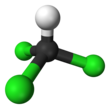คลอโรฟอร์ม
คลอโรฟอร์ม หรือที่รู้จักกันในชื่อ ไตรคลอโรมีเทน (trichloromethane: TCM) เป็นสารประกอบที่มีสูตรเคมี CHCl3 ไม่เกิดการเผาไหม้ในบรรยากาศปกติยกเว้นเมื่อผสมกับสารที่ไวไฟกว่าอื่น ๆ เป็นสารประกอบในกลุ่มไตรฮาโลมีเทน
| |||

| |||
| ชื่อ | |||
|---|---|---|---|
| Preferred IUPAC name
Trichloromethane | |||
| ชื่ออื่น | |||
| เลขทะเบียน | |||
3D model (JSmol)
|
|||
| ChEBI | |||
| ChEMBL | |||
| เคมสไปเดอร์ | |||
| ECHA InfoCard | 100.000.603 | ||
| EC Number |
| ||
| KEGG | |||
ผับเคม CID
|
|||
| RTECS number |
| ||
| UNII | |||
CompTox Dashboard (EPA)
|
|||
| |||
| |||
| คุณสมบัติ | |||
| CHCl3 | |||
| มวลโมเลกุล | 119.37 g·mol−1 | ||
| ลักษณะทางกายภาพ | ของเหลวไม่มีสีที่มีการหักเหของแสงสูง | ||
| กลิ่น | หวาน, มินต์, เพลิดเพลิน | ||
| ความหนาแน่น | 1.564 g/cm3 (−20 °C) 1.489 g/cm3 (25 °C) 1.394 g/cm3 (60 °C) | ||
| จุดหลอมเหลว | −63.5 องศาเซลเซียส (−82.3 องศาฟาเรนไฮต์; 209.7 เคลวิน) | ||
| จุดเดือด | 61.15 องศาเซลเซียส (142.07 องศาฟาเรนไฮต์; 334.30 เคลวิน) สลายตัวที่ 450 °C | ||
| 10.62 g/L (0 °C) 8.09 g/L (20 °C) 7.32 g/L (60 °C) | |||
| ความสามารถละลายได้ | ละลายได้ในเบนซีน ผสมกันได้ในอีเทอร์, น้ำมัน, ลิโกรอิน, แอลกอฮอล์, CCl 4, CS2 | ||
| ความสามารถละลายได้ ใน แอซีโทน | ≥ 100 g/L (19 °C) | ||
| ความสามารถละลายได้ ใน ไดเมทิลซัลฟอกไซด์ | ≥ 100 g/L (19 °C) | ||
| ความดันไอ | 0.62 kPa (−40 °C) 7.89 kPa (0 °C) 25.9 kPa (25 °C) 313 kPa (100 °C) 2.26 MPa (200 °C) | ||
| 3.67 L·atm/mol (24 °C) | |||
| pKa | 15.7 (20 °C) | ||
| UV-vis (λmax) | 250 nm, 260 nm, 280 nm | ||
| −59.30·10−6 cm3/mol | |||
| การนำความร้อน | 0.13 W/(m·K) (20 °C) | ||
ดัชนีหักเหแสง (nD)
|
1.4459 (20 °C) | ||
| ความหนืด | 0.563 cP (20 °C) | ||
| โครงสร้าง | |||
| Tetrahedral | |||
| 1.15 D | |||
| อุณหเคมี | |||
ความจุความร้อน (C)
|
114.25 J/(mol·K) | ||
Std molar
entropy (S⦵298) |
202.9 J/(mol·K) | ||
Std enthalpy of
formation (ΔfH⦵298) |
−134.3 kJ/mol | ||
พลังงานเสรีกิบส์ (ΔfG⦵)
|
−71.1 kJ/mol | ||
Std enthalpy of
combustion (ΔcH⦵298) |
473.21 kJ/mol | ||
| เภสัชวิทยา | |||
| N01AB02 (WHO) | |||
| ความอันตราย[9] | |||
| อาชีวอนามัยและความปลอดภัย (OHS/OSH): | |||
อันตรายหลัก
|
Decomposes to extremely toxic phosgene and hydrogen chloride in presence of light – IARC group 2B – Reproductive toxicity – Specific target organ toxicity (STOT)[4][5][6] | ||
| GHS labelling: | |||
  
| |||
| อันตราย | |||
| H302, H315, H319, H331, H336, H351, H361d, H372 | |||
| P201, P202, P235, P260, P264, P270, P271, P280, P281, P301+P330+P331, P302+P352, P304+P340, P305+P351+P338, P308+P313, P310, P311, P314, P332+P313, P337+P313, P362, P403+P233, P405, P501 | |||
| NFPA 704 (fire diamond) | |||
| จุดวาบไฟ | ไม่ติดไฟ | ||
| ปริมาณหรือความเข้มข้น (LD, LC): | |||
LD50 (median dose)
|
704 mg/kg (mouse, dermal)[7] | ||
LC50 (median concentration)
|
9,617 ppm (rat, 4 hr)[8] | ||
LCLo (lowest published)
|
| ||
| NIOSH (US health exposure limits): | |||
PEL (Permissible)
|
50 ppm (240 mg/m3)[5] | ||
REL (Recommended)
|
Ca ST 2 ppm (9.78 mg/m3) [60-minute][5] | ||
IDLH (Immediate danger)
|
500 ppm[5] | ||
| เอกสารข้อมูลความปลอดภัย (SDS) | [1] | ||
| สารประกอบอื่นที่เกี่ยวข้องกัน | |||
สารประกอบที่เกี่ยวข้อง
|
| ||
หากมิได้ระบุเป็นอื่น ข้อมูลข้างต้นนี้คือข้อมูลสาร ณ ภาวะมาตรฐานที่ 25 °C, 100 kPa
| |||
คลอโรฟอร์มมีประโยชน์ใช้งานหลายอย่าง เป็นสารตั้งต้น ตัวทำปฏิกิริยา และเป็นตัวทำละลาย ไตรคลอโรมีเทนเป็นสารควบคุมเพราะเป็นอันตรายต่อสิ่งแวดล้อม
โครงสร้างของโมเลกุล
แก้โมเลกุลมีโครงสร้างเป็นปิรามิดฐานสามเหลี่ยมที่มี C3v ที่สมมาตร
อ้างอิง
แก้- ↑ "Front Matter". Nomenclature of Organic Chemistry: IUPAC Recommendations and Preferred Names 2013 (Blue Book). Cambridge: The Royal Society of Chemistry. 2014. p. 661. doi:10.1039/9781849733069-FP001. ISBN 978-0-85404-182-4.
The retained names 'bromoform' for HCBr3, 'chloroform' for HCCl3, and 'iodoform' for HCI3 are acceptable in general nomenclature. Preferred IUPAC names are substitutive names.
- ↑ Gregory, William, A Handbook of Organic Chemistry (Third edition corrected and much extended), 1852, page 177
- ↑ Daniel Pereira Gardner, Medicinal Chemistry for the Use of Students and the Profession: Being a Manual of the Science, with Its Applications to Toxicology, Physiology, Therapeutics, Hygiene, Etc (1848), page 271
- ↑ "Part 3 Health Hazards" (PDF). Globally Harmonized System of Classification and Labelling of Chemicals (GHS). Second revised edition. United Nations. เก็บ (PDF)จากแหล่งเดิมเมื่อ 4 March 2019. สืบค้นเมื่อ 30 September 2017.
- ↑ 5.0 5.1 5.2 5.3 NIOSH Pocket Guide to Chemical Hazards. "#0127". National Institute for Occupational Safety and Health (NIOSH).
- ↑ Toxicity on PubChem เก็บถาวร 17 สิงหาคม 2018 ที่ เวย์แบ็กแมชชีน
- ↑ Lewis, Richard J. (2012). Sax's Dangerous Properties of Industrial Materials (12th ed.). ISBN 978-0-470-62325-1.
- ↑ 8.0 8.1 "Chloroform". Immediately Dangerous to Life and Health Concentrations (IDLH). National Institute for Occupational Safety and Health (NIOSH).
- ↑ "PubChem: Safety and Hazards – GHS Classification". National Center for Biotechnology Information, U.S. National Library of Medicine. เก็บจากแหล่งเดิมเมื่อ 17 August 2018. สืบค้นเมื่อ 17 August 2018.
แหล่งข้อมูลอื่น
แก้วิกิมีเดียคอมมอนส์มีสื่อที่เกี่ยวข้องกับ คลอโรฟอร์ม
- Chloroform "The Molecular Lifesaver" – An article at Oxford University providing facts about chloroform.
- Chloroform Administration – a short film of anaesthetic chloroform application, filmed in the 1930s
- Concise International Chemical Assessment Document 58
- IARC Summaries & Evaluations: Vol. 1 (1972), Vol. 20 (1979), Suppl. 7 (1987), Vol. 73 (1999)
- International Chemical Safety Card 0027
- NIOSH Pocket Guide to Chemical Hazards. "#0127". National Institute for Occupational Safety and Health (NIOSH).
- NIST Standard Reference Database


